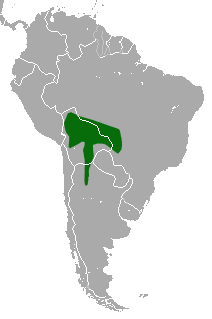| White-bellied woolly mouse opossum | |
|---|---|
|
Scientific classification
| |
| Domain: | Eukaryota |
| Kingdom: | Animalia |
| Phylum: | Chordata |
| Class: | Mammalia |
| Infraclass: | Marsupialia |
| Order: | Didelphimorphia |
| Family: | Didelphidae |
| Genus: | Marmosa |
| Subgenus: | Micoureus |
| Species: | M. constantiae
|
| Binomial name | |
| Marmosa constantiae (
Thomas, 1904)
| |

| |
| White-bellied woolly mouse opossum range | |
| Synonyms | |
|
Micoureus constantiae (Thomas, 1904) | |
The white-bellied woolly mouse opossum (Marmosa constantiae) is a small pouchless marsupial of the family Didelphidae. [2] It was formerly assigned to the genus Micoureus, which was made a subgenus of Marmosa in 2009. [3] The specific epithet was given in honour of Constance Sladen (née Anderson), wife of the naturalist Percy Sladen. She funded the 1902 expedition which collected the type specimen. [4]
Description
This is one of the larger mouse opossums, with a head=body length of 11 to 18 cm (4.3 to 7.1 in), a tail 15 to 23 cm (5.9 to 9.1 in) in length, and weighing from 35 to 144 g (1.2 to 5.1 oz). The fur is thick and woolly, and is grey over most of the body, fading to buffy-yellow on the head and underparts. There are clear, but narrow, rings of black fur around the eyes. The tail is furred only at the base, and is near black for most of its length, but changes suddenly to pale pink along the last third or so. [4]
The feet are broad, with stout claws and ridges on the underside of the toes that aid in climbing trees. Females do not have a pouch, but have fifteen teats arranged in a circle - more than in any of this species' closest relatives. [4]
Distribution and habitat
The opossum is found across northern Bolivia, in the Brazilian states of Mato Grosso and Mato Grosso do Sul, and in northern Argentina as far south as Tucumán Province. [1] It has also recently been reported from Paraguay. [4] Across this region, it inhabits moist tropical forests, often near the boundary with drier habitats, [5] and has been found from near sea level to montane forests as high as 1,000 m (3,300 ft) elevation. [6]
Biology and behaviour
The opossum is arboreal, solitary, and nocturnal, spending most of its time in the forest understory. [7] It is omnivorous, feeding on insects (especially bugs) and vegetable matter. Little is known of their reproductive biology, but they appear to breed throughout the year, and mothers have been captured with up to seven young attached to their teats. [4]
References
- ^ a b Tarifa, T.; Martin, G.M. (2016). "Marmosa constantiae". IUCN Red List of Threatened Species. 2016: e.T13297A22174957. doi: 10.2305/IUCN.UK.2016-1.RLTS.T13297A22174957.en. Retrieved 19 November 2021.
- ^ Gardner, A.L. (2005). "Order Didelphimorphia". In Wilson, D.E.; Reeder, D.M (eds.). Mammal Species of the World: A Taxonomic and Geographic Reference (3rd ed.). Johns Hopkins University Press. p. 12. ISBN 978-0-8018-8221-0. OCLC 62265494.
- ^ Voss, R. S.; Jansa, S. A. (2009). "Phylogenetic relationships and classification of didelphid marsupials, an extant radiation of New World metatherian mammals". Bulletin of the American Museum of Natural History. 322: 1–177. doi: 10.1206/322.1. hdl: 2246/5975. S2CID 85017821.
- ^ a b c d e Smith, P.; Owen, R.D. (December 2016). "Marmosa constantiae (Didelphimorphia: Didelphidae)". Mammalian Species. 48 (941): 123–129. doi: 10.1093/mspecies/sew012.
- ^ Caceres, N.C.; et al. (June 2007). "Mammals of the Bodoquena Mountains, southwestern Brazil: an ecological and conservation analysis". Revista Brasileira de Zoologia. 24 (2): 426–435. doi: 10.1590/S0101-81752007000200021.
- ^ Caceres, N.C.; et al. (May 2011). "Effects of altitude and vegetation on small-mammal distribution in the Urucum Mountains, western Brazil". Journal of Tropical Ecology. 27 (3): 279–287. doi: 10.1017/S0266467410000854. S2CID 62884435.
- ^ Hannibal, W.; Caceres, N.C. (September 2010). "Use of vertical space by small mammals in gallery forest and woodland savannah in south-western Brazil". Mammalia. 74 (3): 247–255. doi: 10.1515/mamm.2010.007. S2CID 73589154.
